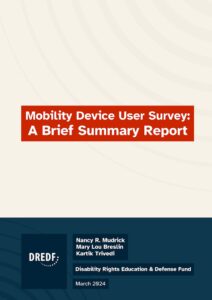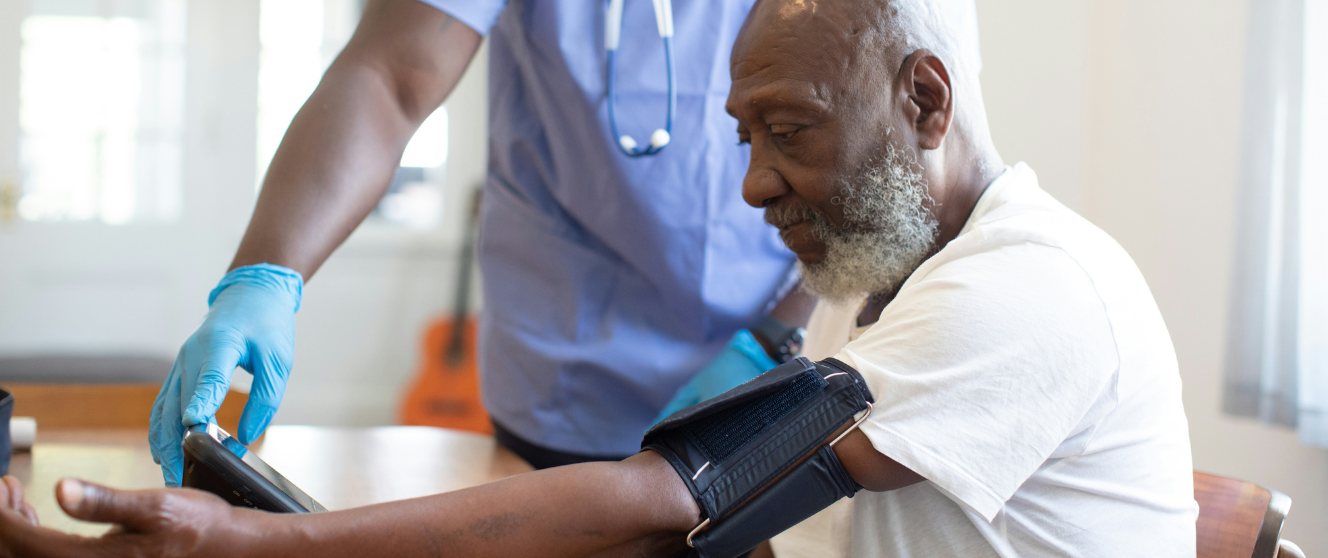
March 2024
By Nancy R. Mudrick, Mary Lou Breslin and Kartik Trivedi
Summary
The Disability Rights Education and Defense Fund (DREDF) carried out the Mobility Device User Survey (MDUS) online in Spring 2023 to understand the on-the-ground experiences of Medicare beneficiaries when they attempted to obtain mobility equipment. The MDUS was fielded in light of the impact of the long-standing Center for Medicare and Medicaid Services (CMS) policy of “in-the-home use” of mobility devices. Additionally, it was prompted by more recent 2005 restrictions excluding consideration of their use for functional activities such as shopping, attending medical appointments, and performing errands.[1] The MDUS is unique in that it captures device acquisition and usage experience among persons who used a mobility device before and after CMS introduced the 2005 restrictions.
The survey questions focused on the use of mobility devices, experiences getting these devices, the processes people followed, and their experiences with the mobility devices they acquired. There were 102 respondents who reported they use Medicare alone or in combination with coverage from Medicaid or private insurance. These survey respondents were overwhelmingly experienced users of mobility devices with 71.4% having used a wheelchair or scooter for 15 or more years. Only 5.5% reported using a wheelchair or scooter for 1-5 years. The largest percentage of respondents had recently acquired a power wheelchair (64.7%); 30.4% had acquired a manual wheelchair (includes simple manual, ultra-light, power assist, and dependent pushed); and 2% had acquired a scooter (see Table 1).
Table 1. Mobility device recently purchased by Medicare beneficiaries
| Mobility device – most recent purchase | Count | Percent |
|---|---|---|
| Powerchair | 66 | 64.7% |
| Manual wheelchair | 16 | 15.7% |
| Dependent (pushed by others) wheelchair | 6 | 5.9% |
| Manual wheelchair with power assist | 5 | 4.9% |
| Ultralight manual wheelchair | 4 | 3.9% |
| Other (please specify) | 3 | 2.9% |
| Scooter | 2 | 2.0% |
| Total | 102 | 100.0% |
Almost two-thirds of users reported their most recent mobility device acquisition process was difficult and many reported denials of medically needed equipment
Respondents were asked about their experiences acquiring their most recent wheelchair or scooter. While many respondents reported the process they experienced in getting their device was very easy or easy, the majority (63.8%) rated their experience as difficult to very difficult.
Insurance coverage was a critical factor in the wheelchair or scooter and accessories that the respondent ultimately acquired. For most respondents (88.2%), occupational or physical therapists were involved in the process of getting their wheelchairs or scooters. Nearly two-thirds of respondents reported that the therapist or supplier advised that insurance might not cover the device and components the individual needed.
Even with clinical justification, forty-one percent reported experiencing an insurance denial (for the type of chair or chair components) within the past five years. Most persons responded to the denial by paying the difference out of pocket or accepting the equipment insurance was willing to cover. Forty-nine percent of respondents reported that their insurance (Medicare, Medicare Advantage, Medicare/Medicaid, or Medicare plus other insurance) did not fully cover the cost of the recently acquired equipment. In the end, even if they contributed out of pocket or accepted the device approved, most users were satisfied with the ability of the device they acquired to meet relevant home and community-based activities. However, one-third of users (32%) reported being dissatisfied or very dissatisfied (Table 2).
Table 2. Satisfaction with ability of wheelchair or scooter to meet home and community-based activity needs
| Level of satisfaction | Count | Percent |
|---|---|---|
| Very satisfied | 27 | 41.0% |
| Satisfied | 41 | 27.0% |
| Dissatisfied | 24 | 24.0% |
| Very dissatisfied | 8 | 8.0% |
| Total | 100 | 100.0% |
Missing Values=2
Respondents explained their reasons for dissatisfaction:
- “Insurance won’t allow for clamps or hooks to help hold the chair in place when traveling. This means when traveling to doctors’ offices drivers have to hook my chair wherever they can which can and has damaged my wheelchair. It also means that sometimes my chair becomes unrestrained mid travel. Then the driver has to stop and rehook me. It also means that if the driver has to stop suddenly my chair can slide.”
- “It is wonderful – but large for inside my smaller home.”
- “Originally they had given her a wheelchair that she could manually do herself, but something broke on it and when they replaced it, they gave her one… someone [has] to push her around now. It was really hard for her to realize that she could no longer get around on her own. No one has helped us get a better wheelchair and we have been given the runaround. She is no longer dependent on herself.”
- “I work a lot on different terrains, and I don’t feel safe when there is a cross slope on terrain that isn’t firm and stable. Insurance wouldn’t cover lights so traveling at night is not safe.”
The majority of users said their most recent device acquisition experience was harder compared to their pre-2005 experience
Of the 102 respondents, 65 rated their most recent equipment acquisition compared to their earlier pre-2005 experience. Approximately 14% rated the recent experience easier, while nearly 34% said it was about the same. However, 52.3% rated it harder or much harder. Asked if they had other information they wished to share, respondents commented especially on how long and difficult the process for approval was, on what they perceived as the insensitive or unreasonable denials by insurance of different wheelchair components, and of the power of the wheelchair suppliers to limit the options and quality of the products available (see Table 3).
Table 3. Respondent comments about the experience of acquiring a wheelchair or scooter
|
Different mobility devices may be required for use indoor versus outdoor
A mobility device that works well for an individual indoors may not facilitate mobility for activities outside of the home, such as doctor’s visits, shopping, and other activities of daily living. While people who use a power wheelchair use it nearly equally in and out of the home, there is greater indoor to outdoor variability for other equipment (Table 4). Respondents reported greater use of scooters outdoors, as well as greater use of manual wheelchairs (including ultra-light, power-assisted, and dependent chair pushed by others). In addition, some people reported using several mobility devices in their home and to enable necessary activities in the community.
Table 4. Mobility devices used by Medicare beneficiaries*
| Type of mobility device | Used when indoors | Used when outdoors |
|---|---|---|
| % of respondents | % of respondents | |
| Cane, crutch, or walker | 16.7% (17) | 7.8% ( 8) |
| Manual wheelchair | 19.6% (20) | 23.5% (24) |
| Ultra light manual wheelchair | 6.9% ( 7) | 8.8% ( 9) |
| Manual wheelchair with power assist | 4.9% ( 5) | 8.8% ( 9) |
| Scooter | 2.0% ( 2) | 5.9% ( 6) |
| Power wheelchair | 65.7% (67) | 67.6% (69) |
| Dependent (chair pushed by others) | 5.9% ( 6) | 9.8% (10) |
| Other | 1.0% ( 1) | 0.0% ( 0) |
*N of respondents=102. Medicare participation includes Traditional Medicare, Medicare Advantage, and dual Medicare & Medicaid.
Conclusions
MDUS results revealed that Medicare beneficiaries encountered significant barriers to acquiring their most recent mobility devices, including ineligibility determinations, even when occupational or physical therapists thought the equipment was medically and functionally necessary. Forty percent of respondents reported that Medicare had denied payment for the mobility devices or accessories they had requested. Many survey respondents noted long waits for approvals, difficulty getting broken chairs or scooters repaired, and limited device options. They reported paying burdensome out-of-pocket copayments for approved devices and for needed but disapproved equipment and accessories. Moreover, most users said their recent device acquisition experience was harder compared with their pre-2005 experience.
The MDUS results raise fundamental questions concerning the impact of restraining disabled mobility device users’ community participation and functional independence at home and in the community by limiting their access to needed equipment. The MDUS has shown that CMS’s attempt to rein in costs, beginning in 2005, has had the added effect of reducing some Medicare beneficiaries’ ability to function in their own homes and travel safely in their communities without concern about equipment failures, breakdowns, and lack of repair options. Specific CMS policies appear to deliberately limit access to community participation, which runs counter to the full community participation and integration mandate of federal disability rights laws, including Section 504 of the 1973 Rehabilitation Act,[2] the 1990 Americans with Disabilities Act (ADA),[3] and the US Supreme Court ADA decision in the Olmstead case.[4]
Considering these effects, legislative and regulatory action is required. Congress should amend the Social Security Act to clarify that the Medicare DME benefit is intended to enable disabled beneficiaries to function at home and in the community. CMS should internally evaluate the extent to which its Medicare DME policies violate Section 504 of the Rehabilitation Act as it applies to federally conducted programs. CMS should also issue regulations indicating that healthcare practitioners should evaluate Medicare beneficiaries requiring mobility devices for the best device to meet their functional needs in their homes and the community. CMS should also review its mobility device repair policies and revise them to ensure Medicare beneficiaries have timely access to repairs. Additional evaluation by CMS is needed to determine the durability and reliability of currently approved mobility devices.
Suggested Citation
Mudrick, N.R., Breslin, M.L., Trivedi, K. (2024). Mobility Device User Survey: A Brief Summary Report, Disability Rights Education & Defense Fund: Berkeley, CA https://dredf.org/2024/03/06/mdus-summary/
Endnotes
[1] Centers for Medicare and Medicaid Services, Decision Memo for Mobility Assistive Equipment (CAG-00274N) (May 5, 2005).
[2] 45 C.F.R. . § 85.21(d).
[3] 42 U.S.C. § 12101(a)(2), (5).
[4] Olmstead v. L.C., 527 U.S. 581 (1999)


